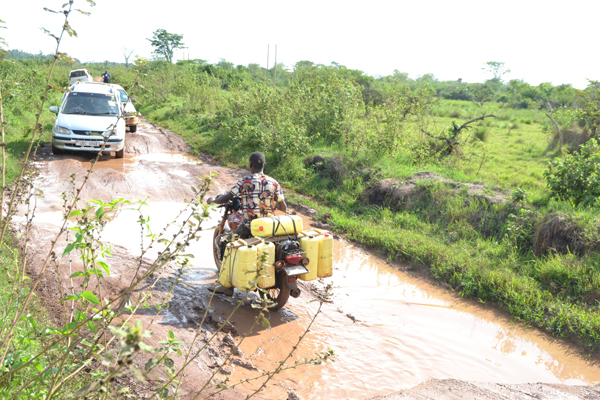Farmers eye new lease of life after Shs3b roadworks fund

Motorists drive on Gayaza- Mityomere road in Mityomere Parish, Wakyato Sub-county, Nakaseke District at the
weekend. PHOTO / DAN WANDERA.
What you need to know:
- The roads funding is supported by government and the Islamic Development Bank under the Local Economic Growth Support project (LEGS).
Smallholder farmers and traders from the cattle corridor areas of Nakaseke District are set to benefit from a Shs3.4 billion roadworks fund targeting grading and improvement of 60.5kms access roads.
The roads funding is supported by government and the Islamic Development Bank under the Local Economic Growth Support project (LEGS).
The initiative that extends to 14 districts, covering a total of 129kms, will cover the badly damaged roads, including the Gayaza- Mityomere 27.5km road where milk dealers and cattle traders incur losses resulting from the poor road network.
Mr Joseph Bakunda, a milk trader from Mityomere Parish in Wakyato Sub-county, said the Gayaza-Mityomere road that is the major transit road for milk dealers and cattle traders from the sub-counties of Kinyogoga and Wakyato, has remained impassable for long.
“It takes several hours to maneuver through the swampy 27km-road to milk collecting centres where the coolers are located. Some milk traders abandon the milk after failing to maneuver through the road. The road upgrade will be a blessing to the farmers,” he said at the weekend.
The district chairperson, Mr Ignatius Kiwanuka Koomu, says the district road maintenance fund is Shs700 million for the Financial Year 2021/2022, which cannot do much work in maintaining the 416kms of roads under the district works programme.
“We are lucky that the government and the Islamic Development Bank recently upgraded the Gwomero-Kagongi and Buwana 30km road at a cost of Shs30m. We are blessed to have the biggest share for the roads maintenance programme amounting to Shs3.4b,” Mr Koomu said.
Livelihood incentive
Under LEGS, the government targets improved livelihoods for the small holder farmers and market accessibility. The project also seeks to address critical issues affecting communities, including accessibility to water for production and the value chain for the different farm produce.
“The good access roads will boost production since the farmers can easily get to the markets. Both the cattle traders and milk leaders are the major beneficiaries. We appeal to the communities to take advantage of the improved road network to boost production,” Capt Yahaya Kakooza, the Nakaseke Resident District Commissioner, said after the commissioning of the Gayaza- Mityomere 27.5km road stretch last week.
The other beneficiary districts under LEGS include Alebtong, Katakwi, Kumi, Kibuku, Gomba, Kyenjojo, Bunyangabu, Kabarole, Ntoroko, Buyende, Buikwe, Adjumani, Rukungiri, and Nwoya.
The government through the Ministry of Local Government is implementing the Islamic Development Bank funded LEGS projects worth Shs213.7 billion for selected districts targeting the small holder farmers livelihood programmes.
Potential
With a population of over 200,000 people, according to the 2012 Uganda National Census, Nakaseke District is renown for farming and cattle keeping.
People grow crops ranging from coffee, maize, beans, cassava, sweet potatoes, and pineapples. In 2020, the corridor, including the neighbouring districts of Nakasongola, was hit by a severe drought that left many cows dead and pastoralists looking for pasture and water.
Last year, available statistics from the district production office indicated that on average, 68,000 litres of milk leave the district for the market daily.





